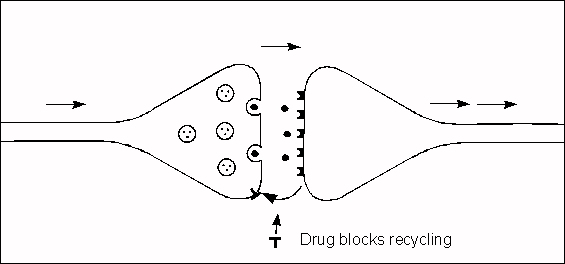1. THE BRAIN
In order to try to understand a little about how drugs work, it is best to
first learn a few facts about the brain. Each human being has:
|
One head |
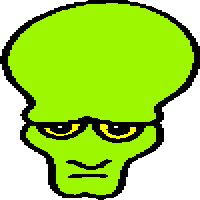
|
|
One brain |
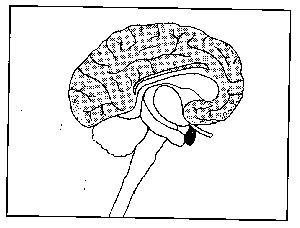 |
|
Each brain has somewhere around 10,000,000,000 brain cells. |
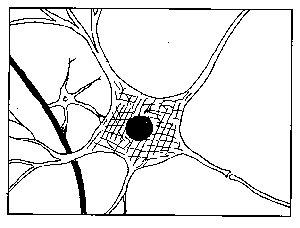
|
|
Each brain cell has lots of connections with other brain cells by means
of nerve fibres (the wiring connecting brain cells together). There are
about 4 million miles of nerve fibres in each brain. Some fibres may have
up to 10,000 branches in them. |
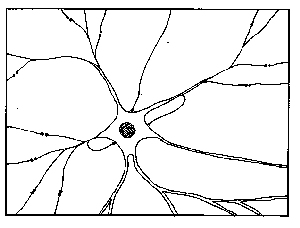 |
|
Each brain cell has lots of connections with other cells, possibly over
25,000! The junctions at the end of the neurones are called synapses.
|
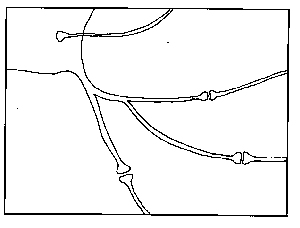
|
As you can see, overall the brain is an extraordinarily complex part of the
body.
For a better quality set of drawings and pictures, click here, although they will
take a little longer to load.

2. A SYNAPSE
(the junction between brain cells)
Synapses are very important because;-
- They are the route by which brain cells talk to each other
- Synapses are of the same basic design in the brain, the heart, the legs
etc.
- There are a lot of them
- If we can get chemicals (e.g. drugs) into the gap between them in the
brain, we can affect the way in which brain cells talk to each other e.g. we
can slow the messages down, speed the up etc.
A synapse looks like this;-
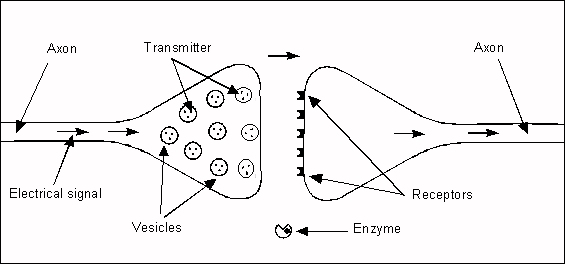
In the drawing you will see the following;-
- Axon - A neurone (or cell body) has many axons (or nerve fibres).
- Vesicles - these contain the transmitter.
- Transmitters - these are small chemicals used by brain cells as
messengers. They are stored in the vesicles in the nerve ending ready to be
released
- Receptors - these are structures on the surface of the receiving
cell which have a space designed just for the transmitter (if the transmitter
is a key, receptors are the lock into which they fit)
- Enzymes - these surround the synapse and break down any spare
transmitter that might leak out to other synapses nearby.
- Electrical signal - This is the way in which one brain cell sends a
message to another. The signal travels down the nerve fibre rather like an
electrical "Mexican Wave".

3. WHAT HAPPENS WHEN A MESSAGE IS PASSED FROM ONE CELL TO ANOTHER
Depending on your browser, the pictures and words may not match
perfectly, but they are both in numerical order so you should be able to work it
out.
|
1. A brain cell decides to send a message to another cell in order to
make something happen e.g. tighten a muscle, release a hormone, think
about something, pass on a message etc.
2. An electrical impulse is sent from the brain cell down one of the
nerve fibres/neurones towards the end. It travels at about 120 miles per
hour.
3. This message or impulse arrives at the end of the nerve fibre. When
it arrives, a chemical ("transmitter") is released from the nerve end.
4. The transmitter is then released and travels across the gap between
the first nerve fibre and the next/receiving one.
5. The transmitter hits a receptor on the other side. It fits into
it just like a key fitting into a lock.
6. When the transmitter hits the receptor, the receptor changes
shape. This causes changes inside the nerve ending which sets off an
electrical message in that nerve fibre on to the next brain/nerve cell.
This sequence then carries on until the effect occurs e.g. the muscle
moves etc.
7. The transmitter is either broken down by enzymes (10%) and removed
or taken back up again into the nerve ending (i.e. recycled) - a process
known as re-uptake.
8. The nerve fibre and synapse is then ready for next
message
|

|
Important points;-
- The passage of messages only works one way or one direction
- There is only one type of transmitter per synapse
- The transmitter allows an electrical message to be turned into a chemical
message and back into an electrical message.

4. "TRANSMITTERS"
Although there are over 80 known different "transmitters" in the brain, each
nerve ending only has one type. These "neurotransmitters" tend to be grouped
together and each seems to have specific roles e.g.;-
|
Transmitter |
What it seems to do |
Problems if it gets out of balance |
|
Serotonin or 5-HT |
In the body, 5-HT is involved with blood pressure and gut control.
In the brain, it controls mood, emotions, sleep/wake, feeding,
temperature regulation, etc. |
Too much serotonin and you feel sick, less hungry, get headaches or
migraines
Too little and you feel depressed, drowsy etc. |
|
Dopamine
- there are three main groups (or pathways) of dopamine neurones in the
brain |
In the brain, one group controls muscle tension and another controls
e.g. emotions, perceptions, sorting out what is real/important/imaginary
etc. |
Not enough dopamine in the first group and your muscles tighten up
(e.g. as in Parkinson's Disease).
Too much dopamine in the second group gives you an overactive brain
i.e. too much "perception e.g. you may see, hear or imagine things that
are not real |
|
Noradrenaline (NA)
(sometimes called "norepinephrine" or NE) |
In the body, it controls the heart and blood pressure.
In the brain, it controls sleep, wakefulness, arousal, mood, emotion
and drive |
Too much noradrenaline and you may feel anxious, jittery etc.
Too little and you may feel depressed, sedated, dizzy, have low blood
pressure etc. |
|
Acetylcholine (ACh) |
In the body, acetyl choline passes the messages which make muscles
contract.
In the brain, it controls arousal, the ability to use memory, learning
tasks etc. |
Too much in your body and your muscles tighten up.
Too little can produce dry mouth, blurred vision and constipation, as
well as becoming confused, drowsy, slow at learning etc. |
|
Glutamate |
Acts as an "accelerator" in the brain |
Too much and you become anxious, excited and some parts of your brain
may become overactive.
Too little and you may become drowsy or sedated |
|
GABA |
Acts as a "brake" in the brain |
Too much and you become drowsy or sedated.
Too little and you may become anxious and
excited |
In many mental health problems, it is known that some of these transmitters
get out of balance e.g. you have too much or too little of a particular
transmitter.

5. DEPRESSION
People with depression usually have problems with poor sleep, low mood and
appetite, loss of energy and interest or pleasure etc. It is a common illness,
affecting 3% of the population per year. The main theory about why this happens
is the so-called "monoamine hypothesis".
We know that serotonin and noradrenaline in the brain are involved with
control of sleep/wake, emotions, mood, arousal, emotion, drive, temperature
regulation, feeding etc.. In depression, it is known that there are reduced levels of serotonin and
noradrenaline. These reduced levels may lead to a lowering of mood. The full reasons
are not fully known but stress may well play a part in causing this.
"Normal" communication between cells:
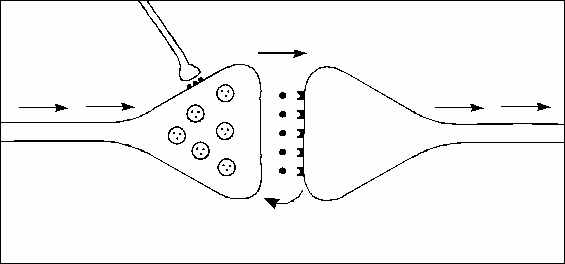
"Less" communication between cells e.g. as in depression:
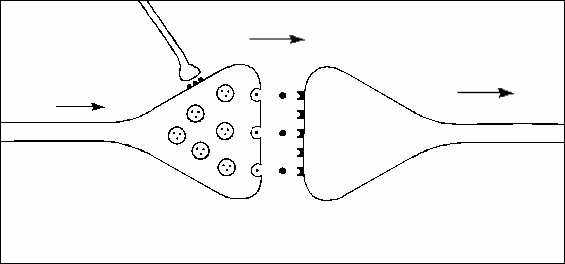
There are lots of other theories about how depression occurs e.g. genetics,
how the brain develops, stress etc. There may in fact be many causes and in each
person there may be a combination of these. Stress may in fact cause changes in
the brain which then result in reduced levels of serotonin and noradrenaline.
Transmitters other than much serotonin and noradrenaline are probably also
involved.

6. HOW SSRI ANTIDEPRESSANTS PROBABLY "WORK"
If too little serotonin (or noradrenaline) produces the symptoms of
depression then correcting this should help to reduce the symptoms. One way of
doing this is to block the reuptake (recycling) of transmitters. This is just
what an SSRI antidepressant does. They block the reuptake of serotonin, so the
next time an impulse comes along, there is more transmitter, a stronger message
is passed, and activity in that part of the brain is increased.
"Normal" nerve activity:

"Reduced" nerve activity e.g. as in depression:

"Reduced" nerve activity but with recycling blocked, and increased
messages passes:
